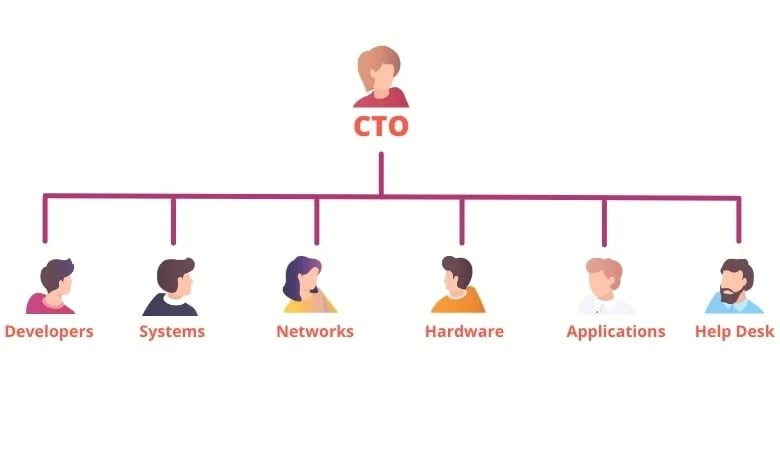No matter what business you specialize in, it's likely that technology plays an integral role.
When it comes time to develop your IT department, there are many things to consider. Will you be hiring in-house or outsourcing?
Many companies do outsource, but you still need an IT organizational structure to start with.
It's far more difficult to restructure your IT department as it grows. Ideally, you want to start with a good structure for your current needs. Then you can add roles as your needs grow. This strategy helps to simplify when it comes time to scale up your IT department.
A smaller company won't need all the roles and specialties. At least, not as permanent staff members. If you organize the hierarchy in advance, it makes the process more transparent for current employees. This strategy also allows you to develop concise job descriptions for a more productive team.
How Do You Build an IT Department?
It seems that no two IT departments are the same. This is because the IT department develops around and with the needs of the company, and every company is unique.
If you have a technology company, the IT department will be an important component.
For many businesses, IT is a necessity but not the purpose of the business. In these cases, IT often functions as a small department.
In some companies, the tasks are wholly outsourced. In these cases, one executive or CIO oversees all the processes under the technology umbrella. That point person works with vendors and managed service providers.
If you're just starting, begin with the basics of what that department will oversee. Generally, you want to include all of your technology needs under this one umbrella.
The IT department will be responsible for your architecture, hardware, software, the way your computers are networked, and other aspects of your technology. Technology isn't a one-size-fits-all specialty, your staff will be composed of professionals with the right background for your company's needs.
Your organizational structure is how you delineate which roles are responsible for which processes. It also lays out the hierarchy so that your teams run smoothly and roles don't get confused. The structure you choose dictates which employees are in management positions and how communications move through your department.
IT Organizational Structure Best Practices
For small businesses, the owner or CEO often takes the brunt of the work and responsibility. This might include heading up the IT needs of the company.
In many small businesses, employees manage their own technology and the company outsources larger needs. This process can work with the right partnerships, but it's also a good idea to solidify the structure so that employees clearly know what their responsibilities are and who they can ask for clarification.
There are several types of structures that a company can employ overall and for each department. Because technology is moving in such a way that cloud computing and hybrid work environments are changing communication, it's important to be as transparent as possible.
Things can get easily confused if there is no clear hierarchy of responsibility. It's also integral to remain flexible. As new opportunities and communications open up in the digital space, there may be more changes ahead for your IT department.
There are four traditional organizational structures for businesses. You may opt for one of these, or you may improvise on one based on your needs...
1. Functional
The functional model is one that separates staff by the type of work that they do. For example, marketing, finance, IT, and admin.
In this model, every staff member working with any aspect of your technology would be in the IT department. Your IT department would be developed based on your company's needs. And that department would be organized by the different specialties and roles in your IT department.
Functional methods are efficient for training and cross-training. With all of your IT personnel in the same department, there are options for mentoring and easy communication.
2. Divisional
The divisional method is often used by larger companies that offer several types of services. The employees would be divided by the products or services that they work with.
For example, if your company was a large fashion manufacturer, you may have divisions based on apparel categories. The accessory's division, women's clothing, men's clothing, etc.
For large companies, the divisions may have their own internal departments, such as marketing and IT for that specific division. In this model, each division would have its own dedicated IT department that works specifically with that division.

Image by Gerd Altmann from Pixabay
3. Matrix
The matrix model is a combination of the functional and divisional models. With this model, you may also split your departments by specialty. So there would be a single IT department. But you would further segment your IT department by the division that they were hired to work with. This model is more complex, but it can be a better way to organize in larger companies with many divisions and personnel to oversee.
4. Flat
Flat structures often have little or no hierarchy. This is a common structure for smaller businesses and startups as there are so few employees.
Rather than having many middle management people between the CEO and staff, there might be an open dialogue, and each employee would largely be responsible for their tasks but not directly managed by any superior, except perhaps the CEO.
A flat model is common among startups as it gives staff control over their own work and some believe it results in a more productive work environment. In this model, IT resources might be unstructured and scattered throughout the business. IT professionals would have the autonomy to work on projects which they deem to be most impactful.
 A Typical IT Org Chart
A Typical IT Org Chart
IT organizational charts can vary. The type of structure you choose depends on the number of employees, the need for organization among divisions, and your company's management structure.
- Do you prefer a management structure where most employees are on an even playing field with fewer supervisors?
- Does a structure with many positions of leadership work better for your company culture?
The typical IT organizational chart is often developed like a pyramid. It mimics the traditional business organizational chart.
You would have the CEO at the top in a business organization, with executives below, then managers, and then employees. This model gives authority to the top and trickles down. It also grants access to set information by staff position and department.
In an IT Department, the head might be the CIO. They would answer to the company CEO and board, and they would offer expertise on all strategies and decisions for the IT department. They may have several specialists below them and staff members.
The IT department can also be organized by project. This might put one person in a leadership position on a project with several staff members working on the same team.
Your organizational structure can evolve as your company expands. This is especially true for your IT department.
Interactive Org Chart - use tools to zoom, view job details, etc... ©Functionly
Designing your own IT Department
Whatever structure you think is right for your IT department, you can run various options using our intelligent org chart creation tools. Either on your own, or with the entire team, you can test out and organize the best way forward.
Get started free, and start creating your org today. Learn about other industry org charts.
~~
Sources
- Four Basic Elements of Organizational Structure, Small Business, Janie Sullivan, 12 Feb 2019
- Best Organizational Structures for a Business, Corporate Finance Institute
Photo Credits
Title header photo: Photo by ThisIsEngineering / Licensed under Pexels




